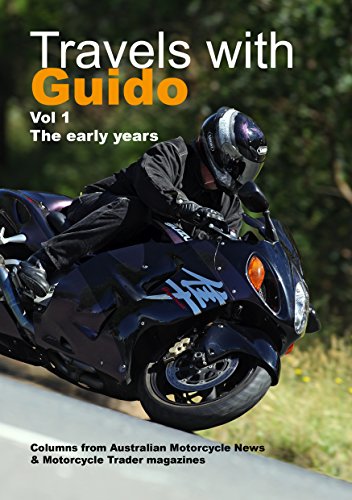Motorcycle Investor mag
Subscribe to our free email news

Fix my ride
New rear shocks
for the big Valk
(Guy 'Guido' Allen, April, 2025)
Thinking back nearly
three years to when I bought the mighty 2001 Honda
Valkyrie Interstate (aka GL1500CF) and rode it home
from a little south of Sydney to Melbourne, there was
a clear need for new rear shocks.
Hit a nasty pothole and,
while the front end would muddle through, the back end
would crash and bang. Not ideal. In pretty well all
other respects the bike was a gem. You could live with
it, knowing that there were times you needed to
exercise discretion. But it was one of a surprisingly
extensive list of things in the over-populated shed
that were bugging me.
The situation came to a
head when the front fork seals gave out, so we got to
freshen-up the sharp end of the bike. Clearly it would
be nice to have both right and I was pretty sure the
original Showas on the rear were simply clagged.

Above: Showa at left
and replacement Ikon at right.
Of the myriad choices
out there I settled for
Ikon (formerly Koni), an Australian-made brand
with which I've had ample experience over the years on
lots of different machinery.

Above: the 1975 Gold
Wing during our recent east-coast tour.
If the choice needed any
confirmation, my recently-acquired and restored 1975
Honda GL1000 was fitted with late-model Ikons and
impressed during a recent ride
down the east coast of Australia to celebrate the
model's 50th birthday.
So,what now? The
appropriate twin-shock set for the Valk is the
sexily-named 7614-1542, which comes in a variety of
trim options such as black or chrome body and springs.
It features the four-way rebound damping adjustment at
the top of the units which some of us have been
playing with for decades.
A newer feature is the
threaded preload adjustment that ours arrived with. It
enables setting the ride height over a subtle range,
rather than the previous stepped three-position
offering. Cost? I've managed to bury the receipt
somewhere, but looking online suggests around Au$750
(US$460, GB£360).

Above: stripping off
the seat and panniers was a good excuse to clean up.
Doing the change-over
from the Showas was also a good excuse to get into
some areas of the machine that rarely see daylight or
a cleaning rag. You have to remove the seat, which
means undoing the two bolts for the pillion strap,
then unlocking it with a key and pulling it forward.
The seat is huge.
You also need to remove
the panniers, which is four bolts each side and pretty
painless. I also took the opportunity to remove and
clean elaborate thin steel plates underneath – an
anti-vibration measure? Another four screws per side.
A necessary tool in my
shed is a decent trolley jack, which made this job a
lot easier. The rear pannier frame/crashbars are
robust enough to use to get the weight off the rear
wheel. We did one side at a time, partly as a
precaution to ensure the bike had some support if
something went wrong with the jack.

Above: some
hand-filing was required to get clearance on the
lower-right mount.
There is no rocket
science to changing over shocks of this type, though
we hit a bit of a snag on the right side. The lower
mount sits in a hollow in the final drive housing and
the latter isn't quite deep enough to host the
slightly larger surround for the lower mount on the
Ikon. So we end up removing a little metal and flatten
the profile of the shock end with a hand file – not
ideal, but no great drama. The other side is fine as
it uses a more conventional and roomy U-shaped
bracket.

Above: the new Ikon
in place – note the threaded ride height adjustment.
At this stage we've
taken a bit of a guess on the set-up and can fine-tune
it easily enough. On the preload front, I've ramped it
up substantially from its low factory setting. The
maker offers some guidelines and warns against going
too far, or risk the spring binding on compression.
As for damping, I've gone straight to four out of four as the bike is heavy and I'm not exactly a jockey. This is not something I'd normally do, but on the Valk we're talking about a hell of a lot weight being thrown around. We'll see how it goes.
The change-over means there's a little less chrome than before – I could have opted for a more 'dressy' presentation. It wasn't an aspect that was on my radar when buying and the difference in the motorcycle's presentation is minimal. As you may have noticed, it's not exactly short of brightwork.
Early impressions are
that we've managed to raise the formerly sagging rear
ride height noticeably. That's a good thing and it
feels like it turns more willingly – more like it was
from the factory. Meanwhile the damping is firm and
isn't bone-shaking.
Recent experience on the
old Gold Wing with similar fresh Ikon units suggests
it takes a few hundred kilometres for the shocks to
bed in properly, so we'll give it a little time and
then work out what if any further adjustments are
required.
An immediate improvement however is a better sense of integrity and control from the rear end. So far so good.

See our Honda
Valkyrie model profile
-------------------------------------------------
Produced by AllMoto abn 61 400 694 722
Privacy: we do not collect cookies or any other data.

Archives
Contact




